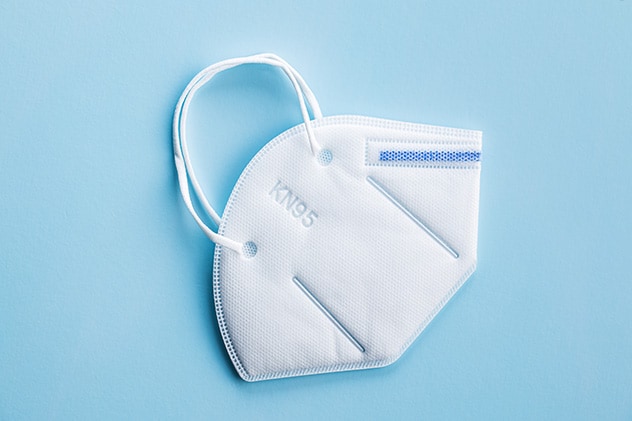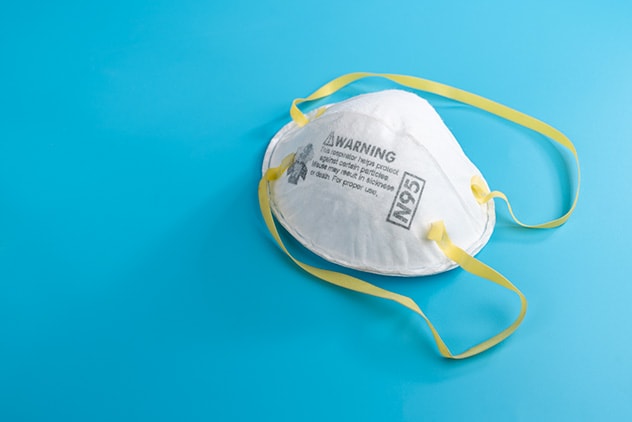How well do face masks protect against COVID-19?
Get answers to your questions about face masks, including how to use them properly.
By Mayo Clinic Staff
The virus that causes COVID-19 spreads mainly through the air when a person coughs, sneezes, sings, talks or breathes. Virus particles can drift in the air and be inhaled, especially in crowded places with poor airflow. Face masks or respirators are products that cover the nose, mouth and chin. Most research finds that these products can slow the spread of the virus that causes COVID-19 when they are worn consistently, fit properly and are worn correctly.
Wear a mask if you have symptoms of illness, if you are near others who are sick or if you're in a crowded indoor area. This is especially important if COVID-19 illness rates in your area are high.
But face masks aren't safe for everyone. Don't put a mask on anyone who has trouble breathing or is unconscious or otherwise unable to remove the mask without help. And don't put masks on children younger than age 2.
How do different types of masks work?
Face masks differ in how well they filter air and fit on the face. Masks also differ on how easy or hard they are to breathe through. Some masks rely on fabric type, weave or density to filter the air. Other masks use a static charge, like the static charge that causes clothes to stick together in the dryer, to catch and hold the virus. Some masks use both strategies as well as others.
Some masks have valves that make them easier to breathe through. But these masks don't filter the air the wearer breathes out. For this reason, masks with valves can't be used in some places.
Respirators

Masks called respirators have to meet specific standards and are designed to block almost all virus particles in the air. These masks include N95, FFP2, KN95 and other types. Respirators approved in the U.S. are called N95s. European respirators are called FFP2s and respirators from China are called KN95s.

This type of mask may be available in a range of sizes and is meant to be adjusted to fit the face. These respirators have adjustable nosepieces and bands or ties. Many respirators can be used more than once. Replace the respirator if it gets wet or dirty or if it's damaged.
Medical masks
Medical masks are loose-fitting and disposable. They're meant to protect you from droplets and sprays, such as mucus from a sneeze. Also called surgical masks, they filter out large particles in the air when you breathe in. Medical masks come in a larger size typically used for adults and a smaller size that may be used for children.

To make medical masks more form-fitting, knot the ear loops where they attach to the mask. Then fold and tuck the loose material under the edges. Also, make sure to pinch the flexible nosepiece if the mask has one. This creates a snug fit over the bridge of your nose.
How to fit and wear a face mask
Masks are most effective if they fit the face closely. Use masks that have bendable nose strips and adjustable ear loops or bands. This helps you fit the mask snuggly to your face, so air and breath move through the mask, not around the edges.
You should feel warm air going out the front of the mask when you breathe out. You shouldn't feel your breath coming out under the edges of the mask. While it may feel like more work to breathe through a respirator or medical mask, the amount of oxygen you breathe into your body and the amount of carbon dioxide you breathe out doesn't change.
Healthy adults may have minor physical changes, such as a small change in breathing rate, while wearing a face mask. This is more likely with respirators than with surgical masks. But these changes don't last or cause problems for most healthy adults.
With all masks, your face may feel warmer or more humid under the mask.
How to put on and take off a face mask
Follow these steps for putting on and taking off your mask.
- Wash or sanitize your hands before putting on your mask.
- Place your mask over your mouth, nose and chin.
- Tie it behind your head or use ear loops. Make sure it's tight against your face.
- Don't touch your mask while wearing it, and if you do, wash or sanitize your hands.
- Take off the mask by untying it or lifting off the ear loops without touching the front of the mask or your face. Fold the outside corners together. Throw away disposable masks or store your reusable mask to wash later.
- Wash your hands immediately after taking off your mask.
Throw away disposable masks either after one use or if they get dirty, wet or damaged during use.
Oct. 29, 2025
- Goldman L, et al., eds. Goldman-Cecil Medicine. 27th ed. Elsevier; 2024. https://www.clinicalkey.com. Accessed Sept. 25, 2025.
- Greenhalgh T, et al. Masks and respirators for prevention of respiratory infections: A state of the science review. Clinical Microbiology Reviews. 2024; doi:10.1128/cmr.00124-23.
- Respiratory infections diseases: How to reduce the spread with personal protective measures. Public Health Agency of Canada. https://workpermitcanada.us/en/public-health/services/diseases/prevent-spread-respiratory-viruses.html. Accessed Sept. 5, 2025.
- Gandhi R. COVID-19: Epidemiology, virology and prevention. https://www.uptodate.com/contents/search. Accessed Oct. 13, 2025.
- Boulos L, et al. Effectiveness of face masks for reducing transmission of SARS-CoV-2: A rapid systematic review. Philosophical Transactions. Series A, Mathematical, Physical, and Engineering Sciences. 2023; doi:10.1098/rsta.2023.0133.
- How to wear a mask. American Lung Association. https://www.lung.org/lung-health-diseases/wellness/masks. Accessed Oct. 13, 2025.
- Respiratory infections diseases: Mask use for reducing the spread. Public Health Agency of Canada. https://www.canada.ca/en/public-health/services/diseases/respiratory-infectious-diseases-reduce-spread-personal-protective-measures/masks.html. Accessed Oct. 13, 2025.
- N95 respirators, surgical masks, face masks, and barrier face coverings. U.S. Food and Drug Administration. https://www.fda.gov/medical-devices/personal-protective-equipment-infection-control/n95-respirators-surgical-masks-face-masks-and-barrier-face-coverings#barrier. Accessed Oct. 14, 2025.
- Coronavirus disease (COVID-19) advice for the public: When and how to use masks. World Health Organization. https://www.who.int/emergencies/diseases/novel-coronavirus-2019/advice-for-public/when-and-how-to-use-masks. Accessed Oct. 17, 2025.
- Respiratory infections diseases: Types of masks. Public Health Agency of Canada. https://www.canada.ca/en/public-health/services/publications/diseases-conditions/types-masks.html. Accessed Oct. 14, 2025.
- Medical review (expert opinion). Mayo Clinic. Oct. 20, 2025.
- Marek EM, et al. Effects of wearing different face masks on cardiopulmonary performance at rest and exercise in a partially double-blinded randomized cross-over study. Scientific Reports. 2023; doi:10.1038/s41598-023-32180-9.
- Masking: How to choose, use and care for masks. Public Health Agency of Canada. https://www.canada.ca/en/public-health/services/publications/diseases-conditions/how-choose-use-care-masks.html. Accessed Oct. 17, 2025.
- Farah W, et al. Safety implications of mask use: A systematic review and evidence map. BMJ Evidence-Based Medicine. 2025; doi:10.1136/bmjebm-2024-113028.